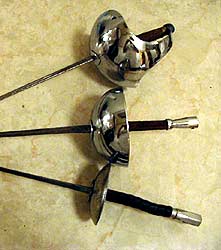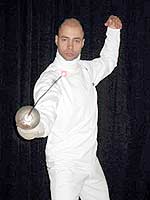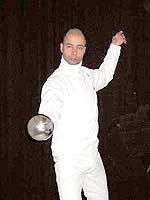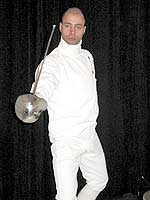Swords of Western Martial Arts
by Ken Mondschein

Saber, epee, and foil.
The epee has a larger guard to protect the hand.
|
As an avid practitioner of European schools of fencing, as well as a
dedicated student of karate-do, it never fails to amaze me how little
of Western swordsmanship is known amongst practitioners of Asian martial
arts. A hundred years ago, anyone wishing to learn
self-defense would have been equally likely to report to a fencing salle
(school) for instruction in cane-fencing as to seek out a master of jujitsu,
which was, at that time, a relatively new and exotic import from the East.
Yet, today, if you mention a katana, everybody knows what you're talking
about: a relatively short Japanese single-edged sword with a curved blade.
But almost no one knows what the heck an epee is. This deplorable situation
plainly cannot be allowed to continue: Western fencing is every bit as
worthy of study as kendo (the Japanese competitive art using bamboo practice
swords), arnis (a Philippine martial art using empty hand as well as stick
and bladed weapon techniques), gung fu (a generic term referring to Chinese
martial arts), or other Asian martial arts. Therefore, for the edification
of all, I present a brief synopsis of some of the weapons used in classical
and modern sport fencing.
The Foil

Edgar de la Vega demonstrates the guard position
with the foil.
|
The first item that should be mentioned is the foil, for foil technique
forms the basis for all fencing. The foil, as we know it today, first
came about in the eighteenth century as a practice stand-in for the short,
light sword gentlemen wore as a part of their daily costume. Because it
is a tool for practice, rather than an actual weapon, foils have no sharp
edges, but rather are rectangular in cross-section. For additional safety,
a foil's point is blunted with a nail head, and then a button is attached,
so that its force of impact is spread out over a relatively wide area.
Foil handles come in a variety of styles, such as the French, the Italian,
and the Spanish (which is a mixture of the first two), as well as various
bizarre "pistol grips." These pistol grips have only come about
since the devolution of fencing into a sport, since using the pistol grip
requires quite different technique than fencers used in the days when
they had to train with the possibility of a life-or-death encounter in
mind.
Foil fencing relies solely on the thrust to score touches upon the opponent.
Because it is a relatively light weapon, and used within the conventional
context of a fencing bout, foil has some of the most complex, elegant,
and difficult techniques of all fencing weapons. In fact, one might say
that it most closely approaches the purest "form" of fencing.
Foil rules enforce good fencing sense, dictating that one must successfully
defend oneself against an opponent's attack before replying with an attack
of one's own. Foilists may score a touch only upon the other's torso;
the head and limbs are off-target.
The Epee

Edgar de la Vega demonstrates the guard position
with the epee. The on guard position points the foil tip to the
eyes and it becomes almost invisable.
|
The epee, like the foil, is also solely a thrusting weapon with unsharpened
edges, though its original purpose was in no way sporting. Rather, the
epee is the dueling sword of the 19th and early 20th centuries, blunted
and with a protective button added. Remove the button and sharpen the
point, and the stiff, triangular blade you hold in your hand is the same
weapon that men used to avenge honor with blood. Note how in this photo
that the weapon is held in such a way that the hand, wrist, and forearm
provide a minimal target.
Epee fencing first came about in the late 19th century as an attempt
more perfectly to simulate the duel, but soon became a competitive event
in its own right. As with foil, epee has strayed even further from its
roots in the past 50 years or so, utilizing pistol grip techniques and
tactics that would have been foolhardy in a duel with sharps.
Ideally, though, epee uses far more conservative actions than the foil.
This conservatism is mandated by the rules the weapon is fenced under,
since epeeists may touch their opponents anywhere on their body, and double-hits
score against both fencers. The hand, wrist, and forearm are thus favored
targets, for a wound there with a sharp weapon would disable an opponent,
while keeping one's own body safely out of distance. A too-radical attack,
such as an ill-conceived lunge to the leg or torso, is likely to be stopped
by a counter thrust to the mask.
The Fencing Saber

Edgar de la Vega demonstrates the guard position
with the saber.
|
The fencing saber is often confused with the military saber, but it is,
in fact, a completely different weapon. Far lighter and faster than the
military weapon, the dueling saber was popular in Italy, and it is upon
this weapon that the fencing saber is based. However, the dueling saber
had a slight curve and was sharpened along the entire length of the front
edge, the first third of the back edge, and equipped with a sharp point,
while fencing sabers made today have straight blades, are slightly lighter,
and usually have Y-shaped cross-sections. (Needless to say, they are also
not sharpened.) Both the practice weapon and its dueling counterpart have
a guard that curves over to protect the fingers, which somewhat affects
the tactics used. The saber guard position places the weapon-hand before
the body, in the optimal position for both attack and defense. Note how
in this photo the saber's guard is angled outwards.
Saber fencing shares some qualities with foil and some with epee. Like
foil, it has conventional rules that dictate that one must defend before
one attacks -- good sense if faced with a three-foot razor blade. It also
has a limited target area, in this case, the head, torso, and arms. Hitting
below the waist is prohibited. However, like epee, it is a serious-minded
weapon, in which the most efficient action is usually the best. Originally,
saber fencing required a certain calmness of mind and steadiness of purpose
that budo exponents would find very familiar. However, like foil and epee,
saber fencing today has moved far away from its roots; modern competitors
are more than willing to suffer a saber cut, provided that their own attack
lands first and scores a point.
These three fencing weapons are still used in the modern sport of fencing,
a fast-paced and athletic game that utilizes electronic scoring apparatus
to register points and places an emphasis on speed and aggression. However,
they also form the curriculum of classical fencing, a martial art descended
from the days when sharp weapons were used in earnest. Classical fencers
seek, above all else, to "hit without being hit," a sound dictum
when someone is trying to run you through with a piece of metal. Classical
fencing places its emphasis on proper technique, economy of motion, and
mental equilibrium.
About The Author:
Ken Mondschein, is a New York City writer and amateur historian. After
achieving a masters degree in European History he became a student of
classical fencing and historical swordsmanship under Maestro Ramon Martinez.
He is also knowledgeable about European classical dressage, the art
of horsemanship, and its history and application in mounted combat.
Other martial arts studies include karate where he is now a student
at the World Seido Karate Organization's New York City headquarters.
Mondschein currently works in textbook publishing and is Associate Editor
for European Sword Arts for FightingArts.com.
|